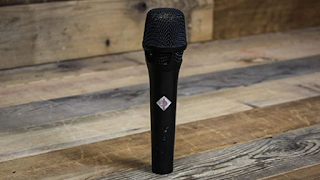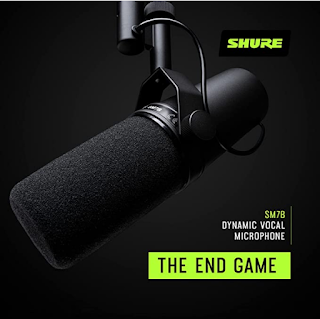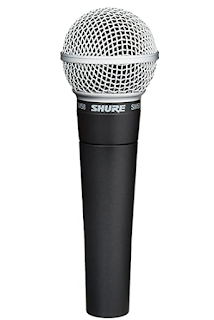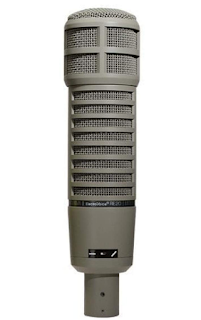Dynamic Microphone: Top 5 Picks | Adnan Mohammed Osman | Electronics Daily

What is a Dynamic Microphone?
Dynamic microphones are microphones that use electromagnetic to turn sound into an electrical signal. Moving coil and ribbon microphones are the two types of microphones. The most popular type of dynamic microphone is the moving coil microphone. Because "moving coil microphone" is such a long-phrase, most sound engineers prefer to refer to them as "dynamic mics" or just "dynamics," classifying ribbon microphones as a separate category. Dynamic microphones are often preferred for use on stage because they are quite sturdy and do not require external power.
Now, let’s get on with the list starting with,
1. Shure SM7B
Basic Information:
- Microphone Type: Dynamic
- Switch: Bass roll-off and mid-range emphasis: Slotted response selector switches.
- Frequency Range: 50 Hz - 20,000 Hz
- Sensitivity: 60 Hz: 11 dB, 500 Hz: 24 dB, 1 kHz: 33 dB
- Output Impedance: 150 ohms
- Weight: 765.4 grams
- Polar pattern: Cardioid
- Connector: Three-pin professional audio (XLR)
Check the price of Shure SM7B here.
2. Shure SM58
The Shure SM58 has held the crown of "Most Popular Vocal Mic in the World" for a long time. Look at images of your favorite performers on stage, and you will see that they are almost always clutching an SM58.
It is ideal for live performances because of its resistance to feedback, durable shell, and ergonomic capsule. And it works just as well in the studio. You would not think that pro studios with unlimited budgets would ever use a $100 mic to record vocals. But it happens all the time. That is why this Shure mic is the obvious choice for any new studio. Frequency response tailored for vocals with brightened mid-range
and bass roll-off to control the proximity effect. Shure SM58 offers effective built-in spherical wind and pop filter.
Basic Information:
- Microphone Type: Cardioid dynamic
- Polar Pattern: Unidirectional
- Frequency Range: 50 Hz - 15,000 Hz
- Batteries: 1 Lithium-ion battery required
- Product Dimensions: 10.31 x 4.92 x 3.31 inches; 1.1 Pounds
- Number of Channels: 1
- Connector Type: XLR Connector
- Connectivity Technology: XLR
Check the price of Shure SM58 here.
3. Electro-Voice RE20
The Electro-Voice RE20 dynamic large-diaphragm cardioid microphone is a popular choice for broadcasting, podcasting, and sound engineering around the globe. It's a
high-end dynamic cardioid microphone that performs like a studio condenser. Its reputation as a high-end instrument microphone also extends to music production. Its Variable-D design and heavy-duty internal pop filter are ideal for close-in voice work, and an inner element shock-mount helps prevent vibration-induced noise. Steel case and hum-bucking coil provide exceptional magnetic shielding and guards against line hum. It offers a
smooth, natural, and controlled aural nature of vintage FM radio voices.
There's also a tone-shaping switch for the mid-bass.
Basic Information:
- Microphone Type: Dynamic
- Polar Pattern: Cardioid
- Frequency Range: 45 Hz - 18,000 Hz
- Impedance: 150 ohms balanced
- Sensitivity: 1.5 mV/pascal (Open Circuit Voltage, 1 kHz)
- Hum Pickup Level: -130 dBm (typically 60 Hz/1 millioersted field)
- Polarity: Pin 2 will be positive referenced to Pin 3 with positive pressure on diaphragm
- Dimensions: 8.53"(L) X 2.14"(W) X 1.94"(D); 216.7 mm (L) X 54.4 mm (W) X 49.2 mm (D)
- Net Weight: 1 lb (737 g)
Check the price of Electro-Voice RE20 here.
4. Sennheiser e945 / Sennheiser MD421 II
For the number 4 spot, I couldn’t decide between Sennheiser e945 and Sennheiser MD421 II. So, I have put them both on this list.
Sennheiser e945

The Sennheiser e945 is
a super-cardioid lead vocal stage microphone specially designed to perform under pressure while exhibiting a naturally smooth response. It is a dynamic super-cardioid vocal microphone with a narrower pickup pattern. Rich in detail, the ideal choice when the vocals have to cut through. Metal construction is rugged, reliable and the shock-mounted
capsule reacts in low sensitivity to impact and handling noise. The super-cardioid pickup pattern insulates from other on-stage signals and a
neodymium ferrous magnet with boron for keeping the microphone stable despite the climate.

Basic Information:
- Brand: Sennheiser Pro Audio
- Material: Metal
- Microphone Type: Super-cardioid Dynamic
- Polar Pattern: Unidirectional
- Frequency range: 40 Hz - 18000 Hz
- Product Dimensions: 10.4 x 4.5 x 3 inches; 11.64 Ounces
- Nominal impedance: 350 Ω
- Number of Channels: 1
- Connector Type: XLR-3
Sennheiser MD421 II

The Sennheiser MD421 II is, without a doubt, the most versatile of all the microphones on our
list. It works well on vocalists, guitar cabs, toms, percussion, and even bass instruments. It is certainly not the best mic on the market,
and it lacks nearly all extra features. There are no noteworthy features
of this mic other than its five-position bass roll-off. Despite these
flaws, this Sennheiser microphone remains the King of all dynamic microphones! Because when it
comes to sound, it is practically perfect. It is a rugged professional
microphone with a five-position bass roll-off switch, effective feedback
rejection, clear sound reproduction, and easy handling due to
pronounced directivity. So that is why if you ask any audio
professional, “If you could only have one dynamic mic, which would you
choose?” there is a fair probability the Sennheiser MD421 II would come out on top.

Basic Information:
- Microphone Type: dynamic
- Polar Pattern: Unidirectional
- Brand: Sennheiser Pro Audio
- Color: Black
- Product Dimensions: 5.31 x 2.6 x 13.78 inches; 7.05 Ounces
- Number of Channels: 1
- Connector Type: XLR-3
- Connectivity Technology: Wired
Check the price of Sennheiser MD421 II here.
5. Neumann KMS 105

The KMS 105 is primarily designed as a handheld vocal microphone but can be used for other stage applications as well, due to its high SPL capability and wide dynamic range. Examples include percussion, saxophone, trumpet,
trombone, harmonica, acoustic guitar, and guitar cabinets. Thanks to its superior sound quality, the KMS 105 is also an excellent microphone for home recording and broadcast applications. Because it is optimized for close-mic placement, the KMS 105 will pick up a dry sound with very little ambiance, which is a big advantage in untreated rooms. Tight super-cardioid pattern without off-axis coloration and unaffected by extreme sound pressure levels.
Rugged construction with feedback resistant, built-in pop screen and
very low handling noise.

Basic Information:
- Acoustical operating principle: Pressure gradient transducer
- Directional Pattern: Supercardioid
- Frequency Range: 20 Hz - 20,000 Hz
- Sensitivity at 1 kHz into 1 kohm: 4.5 mV/Pa ± 1 dB equ. -47 dBV
- Rated Impedance: 50 ohms
- Rated load impedance: 1 kohms
- Equivalent noise level, CCIR: 28 dB
- Equivalent noise level, A-weighted: 18 dB-A
- Maximum SPL for THD 0.5%: 150 dB
- Signal-to-noise ratio, CCIR (re. 94 dB SPL): 66 dB
- Signal-to-noise ratio, A-weighted (re. 94 dB SPL): 76 dB
- Maximum output voltage: 12 dBu
- Supply voltage (P48, IEC 61938): 48 V ± 4 V
- Current consumption (P48, IEC 61938): 3.5 mA
- Matching connector: XLR 3 F
- Weight (approx): 300 g
- Diameter: 48 mm
- Length: 180 mm
Check the price of Neumann KMS 105 here.
Do you agree with this list? Let us know which one is your favorite down below! You can also check out the 5 best condenser microphones list, click here to read.
If you want to see my previous post, click here. For similar content, you can follow my website or follow me on Quora and Medium for more updates. Thank You, have a great day!






No comments